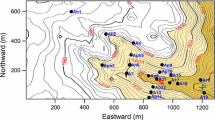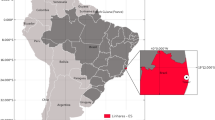Abstract
Information concerning the average wind speed and the variances of lateral and longitudinal wind velocity fluctuations is required by dispersion models to characterise turbulence in the atmospheric boundary layer. When the winds are weak, the scalar average wind speed and the vector average wind speed need to be clearly distinguished and both lateral and longitudinal wind velocity fluctuations assume equal importance in dispersion calculations. We examine commonly-used methods of estimating these variances from wind-speed and wind-direction statistics measured separately, for example, by a cup anemometer and a wind vane, and evaluate the implied relationship between the scalar and vector wind speeds, using measurements taken under low-wind stable conditions. We highlight several inconsistencies inherent in the existing formulations and show that the widely-used assumption that the lateral velocity variance is equal to the longitudinal velocity variance is not necessarily true. We derive improved relations for the two variances, and although data under stable stratification are considered for comparison, our analysis is applicable more generally.
Similar content being viewed by others
References
Anfossi D, Alessandrini S, Trini Castelli S, Ferrero E, Oettl D, Degrazia G (2006) Tracer dispersion simulation in low wind speed conditions with a new 2D Langevin equation system. Atmos Environ 40: 7234–7245
Bernstein AB (1967) A note on the use of cup anemometers in wind profile experiments. J Appl Meteorol 6: 280–286
Cirillo MC, Poli AA (1992) An intercomparison of semiempirical diffusion models under low wind speed, stable conditions. Atmos Environ 26: 765–774
EPA (2000) Meteorological monitoring guidance for regulatory modeling applications. EPA-454/R-99-005. U.S. Environmental Protection Agency, Research Triangle Park, NC (USA), 171 pp. http://www.epa.gov/scram001/guidance/met/mmgrma.pdf
Etling D (1990) On plume meandering under stable stratification. Atmos Environ 24: 1979–1985
Fisher NI (1987) Problems with the current definitions of the standard deviation of wind direction. J Clim Appl Meteorol 26: 1522–1529
Hanna SR (1983) Lateral turbulence intensity and plume meandering during stable conditions. J Clim Appl Meteorol 22: 1424–1430
Irwin JS (1983) Estimating plume dispersion—a comparison of several sigma schemes. J Clim Appl Meteorol 22: 92–114
Leahey DM, Hansen MC, Schroeder MB (1988) An analysis of wind fluctuation analysis collected under stable atmospheric conditions at three sites in Alberta, Canada. J Appl Meteorol 27: 774–777
Leung DYC, Liu CH (1996) Improved estimators for the standard deviations of horizontal wind fluctuations. Atmos Environ 30: 2457–2461
Luhar AK, Rao KS (1994) Lagrangian stochastic dispersion model simulations of tracer data in nocturnal flows over complex terrain. Atmos Environ 28: 3417–3431
Moreira DM, Tirabassi T, Carvalho JC (2005) Plume dispersion simulation in low wind conditions in stable and convective boundary layers. Atmos Environ 39: 3643–3650
Mori Y (1986) Evaluation of several “single-pass” estimators of the mean and the standard deviation of wind direction. J Clim Appl Meteorol 25: 1387–1397
Oettl D, Almbauer RA, Sturm PJ (2001) A new method to estimate diffusion in stable, low-wind conditions. J Appl Meteorol 40: 259–268
Sagendorf JF, Dickson CR (1974) Diffusion under low windspeed, inversion conditions. NOAA Technical Memorandum. ERL ARL-52, Air Resources Laboratory, Idaho Falls, 89 pp
Sharan M, Yadav AK (1998) Simulation of diffusion experiments under light wind, stable conditions by a variable K-theory model. Atmos Environ 32: 3481–3492
Thomson DJ, Manning AJ (2001) Along-wind dispersion in light wind conditions. Boundary-Layer Meteorol 98: 341–358
Hurk BJJM, Bruin HAR (1995) Fluctuations of the horizontal wind under unstable conditions. Boundary-Layer Meteorol 74: 341–352
Weber R (1991) Estimator for the standard deviation of wind direction based on moments of the Cartesian components. J Appl Meteorol 30: 1341–1353
Weber RO (1998) Estimators for the standard deviations of lateral, longitudinal and vertical wind components. Atmos Environ 32: 3639–3646
Yadav AK, Sharan M (1996) Statistical evaluation of sigma schemes for estimating dispersion in low wind conditions. Atmos Environ 30: 2595–2606
Yamartino RJ (1984) A comparison of several “single-pass” estimators of the standard deviation of wind direction. J Clim Appl Meteorol 23: 1362–1366
Author information
Authors and Affiliations
Corresponding author
Rights and permissions
About this article
Cite this article
Luhar, A.K. Estimating Variances of Horizontal Wind Fluctuations in Stable Conditions. Boundary-Layer Meteorol 135, 301–311 (2010). https://doi.org/10.1007/s10546-010-9480-5
Received:
Accepted:
Published:
Issue Date:
DOI: https://doi.org/10.1007/s10546-010-9480-5




